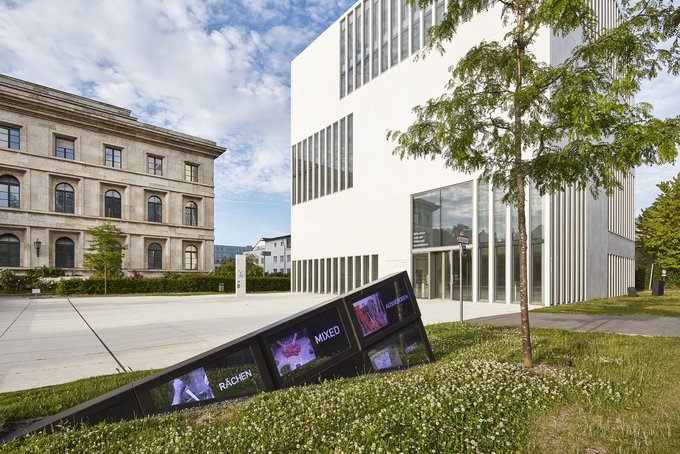
Sitting in the centre’s busy café, surrounded by incongruously cheerful tourists, I was feeling uneasy. This wasn’t the fault of the fare, it was wonderful, it was more that something about the place felt ‘off.’
I had approached the entrance, as all visitors must, by passing a series of half-buried TV monitors blazing with obscure video art. A striking visual spectacle, it must be said, but one that left a little to be desired.
The building itself is a maroon of minimalism adrift in a sea of neo-classicism. It’s making a clear attempt to be different but it feels somehow apologetic in making that statement, as if architects (Berlin-based Georg, Scheel & Wetzel) had aimed for the brand of public importunity favoured by the Gehry/Liebeskind school but lost confidence and rubbed out all the interesting bits although, intriguingly, from some angles its shapes do recall the utile construction of Atlantic Wall blockhouses (which themselves are reminiscent of such medieaval militaristic fetish objects as helmets and chain mail gloves). It’s unclear if this is some kind of Postmodern statement or just unfortunate.
Inside the visual quiet continues. More stark concrete, this time punctuated by some rather subtle way-finding. Where my visit proper was to begin was hard to locate. It turned out to be on the 4th floor, from the heights of which an extraordinarily dense narrative timeline of Nazism escorted me the 4 floors back downstairs. The sheer volume of content was overwhelming but more tiresome were a number of unnatural breaks in the exhibit, a direct result of the buildings floor plan. These left me confused as to where I should go next and created a disconnect between the building and contents that made proceedings feel temporary, somewhat undermining the institutions’ authority.
Drinking a post-lunch espresso, I understood that my bugbear with the establishment was more fundamental than either architecture or exhibition design. The building stands on the site of the so-called Brown House, a villa converted into a party HQ in 1930. Largely destroyed by Allied bombing the site was eventually cleared in 1947 and grassed over – the initial German governmental response to recent history.
Drinking a post-lunch espresso, I understood that my bugbear with the establishment was more fundamental than either architecture or exhibition design.
It was not until the 1980s that a movement known as the Culture of Remembrance emerged with the express aim of ensuring that the horrors of National Socialism would not be forgotten. Their tool was the overt identification of key sites in Third Reich history. The DCNS was imagined in 1988 by its current director, Dr. Winfried Nerdinger, as being part of this. Its merits were argued by the Municipal council for many years before finally being green-lighted. It eventually opened in 2015 but strangely the location, architecture and contents concept were ideated right at end of the planning process (which may explain some of the disconnect mentioned earlier?)
I placed my dishes on a pile in the handy receptacle next to the serving hatch and considered Hannah Arendt’s famous thesis about banality and evil. In her book on the Eichmann trial she posited the thought that those who committed atrocities in the name of Nazism had been able to do so because of the mechanical effectiveness with which the Third Reich operated; Nazism made terrorism easy by replacing ethics with bureaucracy and thus normalised the most appalling of crimes.
I left the building and walked onto the plaza outside, a space once host to the massive propaganda rallies that demonstrated the might of the Party. Fascism communicates in hyperbole and rhetoric, the DCHNS establishes its opposition by speaking in hushed, inoffensive tones but in so doing it has made itself unremarkable. Despite (or because) of this Dr. Nerdinger has been very vocal in stating that the centre is significant because it is a democratic occupation of a site where the “perpetrators who carried out the crimes actually sat.”
Authenticity is always to be applauded but walking once again past the Debordian half-buried TVs and away from the site, I couldn’t help but wonder if this particular subjugation was the right choice? Alternate, non-physical means, say an online archive, would have probably brought its message to a wider audience but I also knew that when the centre opened in Spring 2015 it immediately drew regular communiques from the far right calling for its immediate demolition whilst the earlier agrostologic approach hadn’t worked as the resultant green void became tantamount to a Hitler shrine.
Clearly for the sake of symbolism something had to be built, no doubt why the DCNS seemed like a good idea. Its aim is noble, but in practice it negates its own existence – the truths that it speaks too readily obscured by the noise of package holiday makers, their happy selfies a semiotic cleanser that renders the crimes of Nazism commonplace once again.
www.nsdoku.de
Many thanks to Dr. Winfried Nerdinger and the staff of the DCNS for granting the personal interview and site visit that formed the basis of this report.

